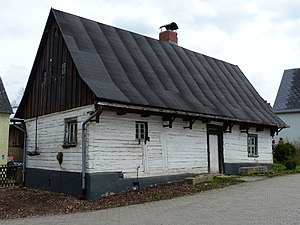Dienesn Heisla
The Dienesn Heisla is a one-story retail building in block construction in the municipality Regnitzlosau in Upper Franconia , the dendrochronologically was dated to the year 1659/60. It is a registered monument .
Location and historical classification
Dienesn Heisla is located at Hauptstraße 9 in Regnitzlosau, near the St. Agidien Church . In the immediate vicinity there is another listed house with a tailcoat roof from the 18th century, which as a residential stable has other characteristic features of the region. While all other log houses in the village from that time were later replaced by half-timbered and massive stone buildings, this house was able to remain due to special family circumstances. It was also considered a “ little inheritance ”. The Dienesn Heisla is an example of a cultural-historical area of life in the Fichtelgebirge and Franconian Forest .
description
The Dienesn Heisla is a single-storey small house in block construction. According to a dendrochronological report on logs, it dates from 1659/60. In the monument protection list it is listed under the designation D-4-75-161-2. The building was initially a trumpet house , which over time also included real estate. The stable and barn built in 1823 were demolished in the 1970s when the current food market was built.
The entrance leads into an anteroom; from there the living room, the kitchen, the attic and the cellar with its barrel vault and a water point are accessible. The original black kitchen with an open hearth, in which the resulting soot stained the kitchen ceiling black, was equipped with a fixed oven, a brick fireplace and a Prussian cap ceiling in the 19th century .
The largest room on the ground floor is the living room with a tiled stove that was used as a stove in the kitchen. In the attic there is the former bedroom and another room that was used for storing tools and supplies.
History and naming
The Dienesn Heisla was, with one interruption, continuously owned by the Gräßel family. Starting with the current owner, 18 generations can be traced back to their first mention in the Hofer official description of 1390.
The nickname Tinis for some Gräßels lines comes from Martin Gräßel, who was born in 1728. This led to the name "Tinis'n Heisla", which later became "Dienesn Heisla".
In 1737 the tailor and lime burner Johann Nickl Gräßel bought the log house. His grandson Johann Wolfgang bought meadows and fields and built a stable and barn in 1820 to keep 4 to 6 draft oxen for the lime distillery. From the end of the 17th to the middle of the 19th century, the Gräßel ran the lime distillery in Losau together with up to four other families. Many of them died before the age of 50, such as the 33-year-old Heinrich in 1832, whose widow and two children had to sell the inheritance to Hans Luding, probably due to the inheritance claims of his seven siblings. In 1890 the wealthy lime distiller Adam Gräßel bought the house for his daughter Margarete, who now managed the 7 hectare estate with her husband, the baker's son Georg Gräßel. The youngest of their seven children stayed, Karl. in the yard.
Individual evidence
- ↑ a b List of monuments for Regnitzlosau at the Bavarian State Office for Monument Preservation, page 1.
Coordinates: 50 ° 17 ′ 59.2 ″ N , 12 ° 2 ′ 46.8 ″ E
